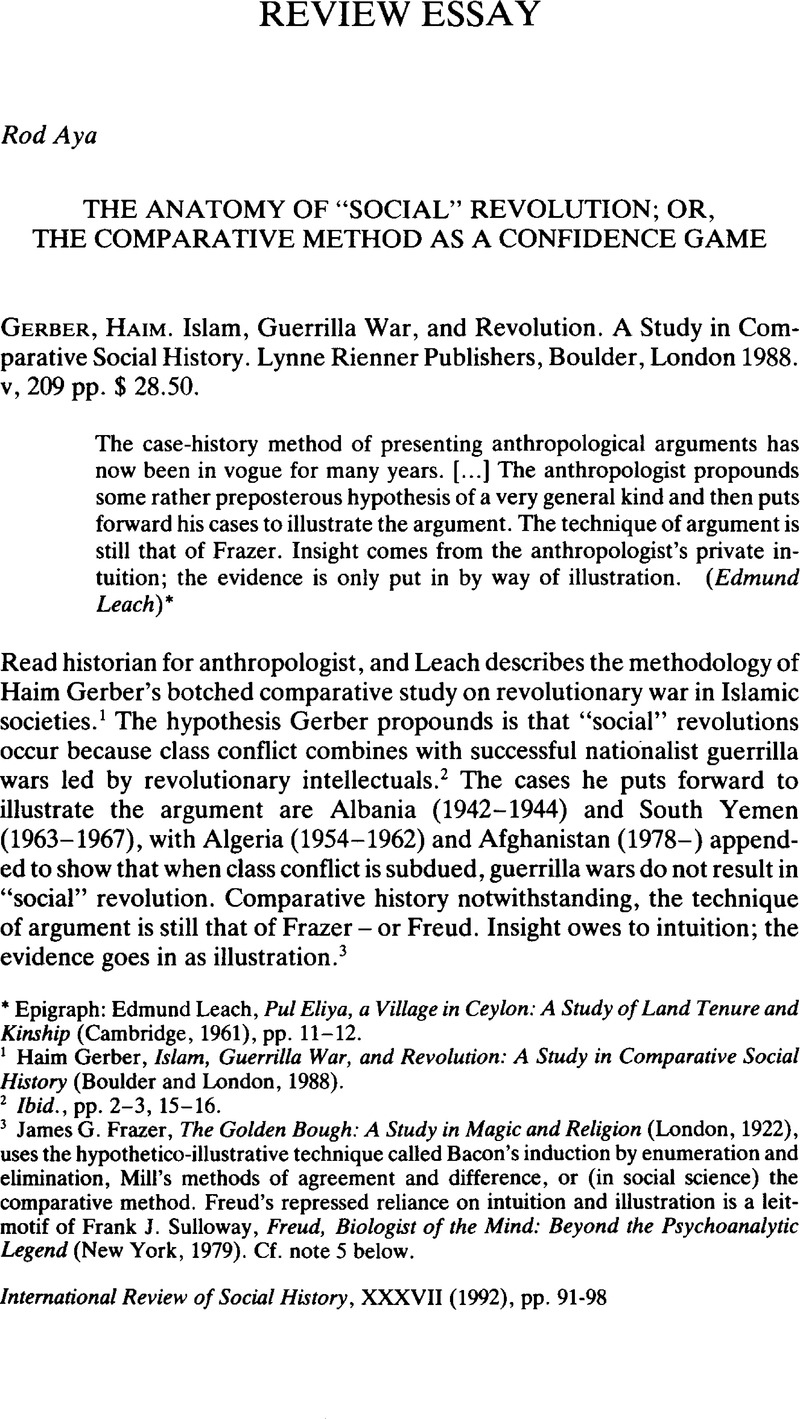No CrossRef data available.
Published online by Cambridge University Press: 18 December 2008

1 Gerber, Haim, Islam, Guerrilla War, and Revolution: A Study in Comparative Social History (Boulder and London, 1988).Google Scholar
2 Ibid., pp. 2–3, 15–16.
3 James, G. Frazer, The Golden Bough: A Study in Magic and Religion (London, 1922),Google Scholar uses the hypothetico-illustrative technique called Bacon's induction by enumeration and elimination, Mill's methods of agreement and difference, or (in social science) the comparative method. Freud's repressed reliance on intuition and illustration is a leitmotif of Frank, J. Sulloway, Freud, Biologist of the Mind: Beyond the Psychoanalytic Legend (New York, 1979). Cf. note 5 below.Google Scholar
4 Skocpol, Theda, “Emerging Agendas and Recurrent Strategies in Historical Sociology”, in Skocpol, Theda (ed.), Vision and Method in Historical Sociology (Cambridge, 1984), pp. 356–391,CrossRefGoogle Scholar the methodological pedigree of Skocpol, Theda, States and Social Revolutions: A Comparative Analysis of France, Russia, and China (Cambridge, 1979), scores an own goal.CrossRefGoogle Scholar
5 Skocpol contends the comparative method can “validate”, not merely “illustrate” hypotheses (States, p. 38),Google Scholar though that is a fallacy (Karl, R. Popper, The Logic of Scientific Discovery (London, 1972), pp. 27–145, 251–281).Google Scholar The most it can do is test hypotheses by producing exceptions, even as theorists seldom subvert their own ideas by researching counterevidence: competitors do that (Karl, R. Popper, The Open Society and Its Enemies, 2 vols (London, 1966), 2, pp. 260, 267, 217, 218, 220, 221).Google Scholar
6 Gerber, , Islam, pp. 5, 6.Google Scholar
7 It transpires that the “takeover by the Albanian Communist party may properly be called a social revolution”, also that South Yemen “became a Marxist country. The South Yemeni revolution thus clearly qualifies as a radical social revolution” (Ibid., pp. 32, 48).
8 Sic transit gloria mundi. Gerber shows the danger of reading Communist revolutions as the culmination or consummation of history. The very idea now sounds anachronistic, even oxymoronic.
9 Gerber, , Islam, pp. 6–7, 178–179, 17, 8.Google Scholar Gerber loans “decentralized sharecropping” from Jeffery, M. Paige, Agrarian Revolution: Social Movements and Export Agriculture in the Underdeveloped World (New York, 1975), pp. 58–71, 358–376.Google Scholar
10 Gerber, , Islam, pp. 16, 179.Google Scholar
11 Ibid., pp. 16–17, 178–179.
12 Ibid., pp. 9, 185.
13 These peremptory remarks on explanation proceed from Rethinking Revolutions and Collective Violence: Studies on Concept, Theory, and Method (Amsterdam, 1990), which I cite as an excuse for not going into detail here.Google Scholar
14 Gerber, , Islam, pp. 15, 177, 11–12, 2–4, 180–185.Google Scholar
15 Ditto note 13 above. The monograph cited there presents the homework behind this contentious paragraph.
16 Gerber's hit-or-miss class analysis of Albania and South Yemen (Islam, pp. 35–42, 53–88)Google Scholar looks for “signs of discontent” with the “reigning social order” because if (as he assumes) “social” revolutions owe in part to “deep resentment” of an “extremely inegalitarian social structure” (Ibid., p. 78), he needs independent evidence for that leg of his explanatory argument to avoid circularity. If evidence exists that lower-class discontent with “social structure” indeed motivated revolutionary violence, Gerber keeps it well hidden.
17 Ibid., pp. 174, 41, 45, 196, 96.
18 On that hypothesis and its critics see Johnson, Chalmers, “Peasant Nationalism Revisited: The Biography of a Book”, China Quarterly, 72 (1977), pp. 766–785,CrossRefGoogle Scholar together with Johnson, Chalmers, Peasant Nationalism and Communist Power: The Emergence of Revolutionary China, 1937–1945 (Stanford, 1962).Google Scholar
19 Gerber, , Islam, pp. 173, 101.Google Scholar Note that the “final turn to Marxism” in South Yemen occurred in June 1969 whereas the British had quit Aden in November 1967. Gerber admits he cannot explain the delay (Ibid., pp. 102, 97, 103).
20 Ditto note 13 above.
21 Home, Alistair, A Savage War of Peace: Algeria, 1954–1962 (London, 1977), pp. 27, 136–138, 406–407.Google Scholar
22 Gerber, , Islam, pp. 105, 112, 115, 124.Google Scholar
23 Postdating Eric, R. Wolf, Peasant Wars of the Twentieth Century (New York, 1969), pp. 211–247, by nearly two decades, Gerber's chapter on Algeria represents a regression – in research, theory, and style – delightful to disbelievers in cumulation.Google Scholar
24 Gerber, , Islam, pp. 148, 149, 153, 147.Google Scholar Thus oversold, comparative study sounds more like a cargo cult than a confidence game. Either way, the revolution in sociology Gerber credits to the comparative method is a secret he alone seems to know. Puzzled readers might ponder Tilly, Charles, Big Structures, Large Processes, Huge Comparisons (New York, 1984), which – with no trace of malice aforethought – confirms for comparative historical sociology the point Leach makes about contemporary ethnographic anthropology in the epigraph above.Google Scholar
25 Ginzburg, Carlo, Ecstasies: Deciphering the Witches' Sabbath (London, 1990), p. 67.Google Scholar
26 John, Maynard Keynes, A Treatise on Probability (London, 1973), p. 273,Google Scholar after Frazer, , Golden Bough, p. 225. Modern ethnography records copious cases of “curious superstition involving the comparative method”.Google Scholar
27 The award ceremony is chapter 5 of the monograph cited in note 13 above or “La révolution en échec: Des situations révolutionnaires sans dénouements révolutionnaires”, Revue française de sociologie, 30 (1989), pp. 559–586.Google Scholar
28 Sylvia, L. Thrupp, doyenne of comparative study, often warns of this danger: in Raymond, Grew and Nicholas, H. Steneck (eds), Society and History: Essays (Ann Arbor, 1977).Google Scholar